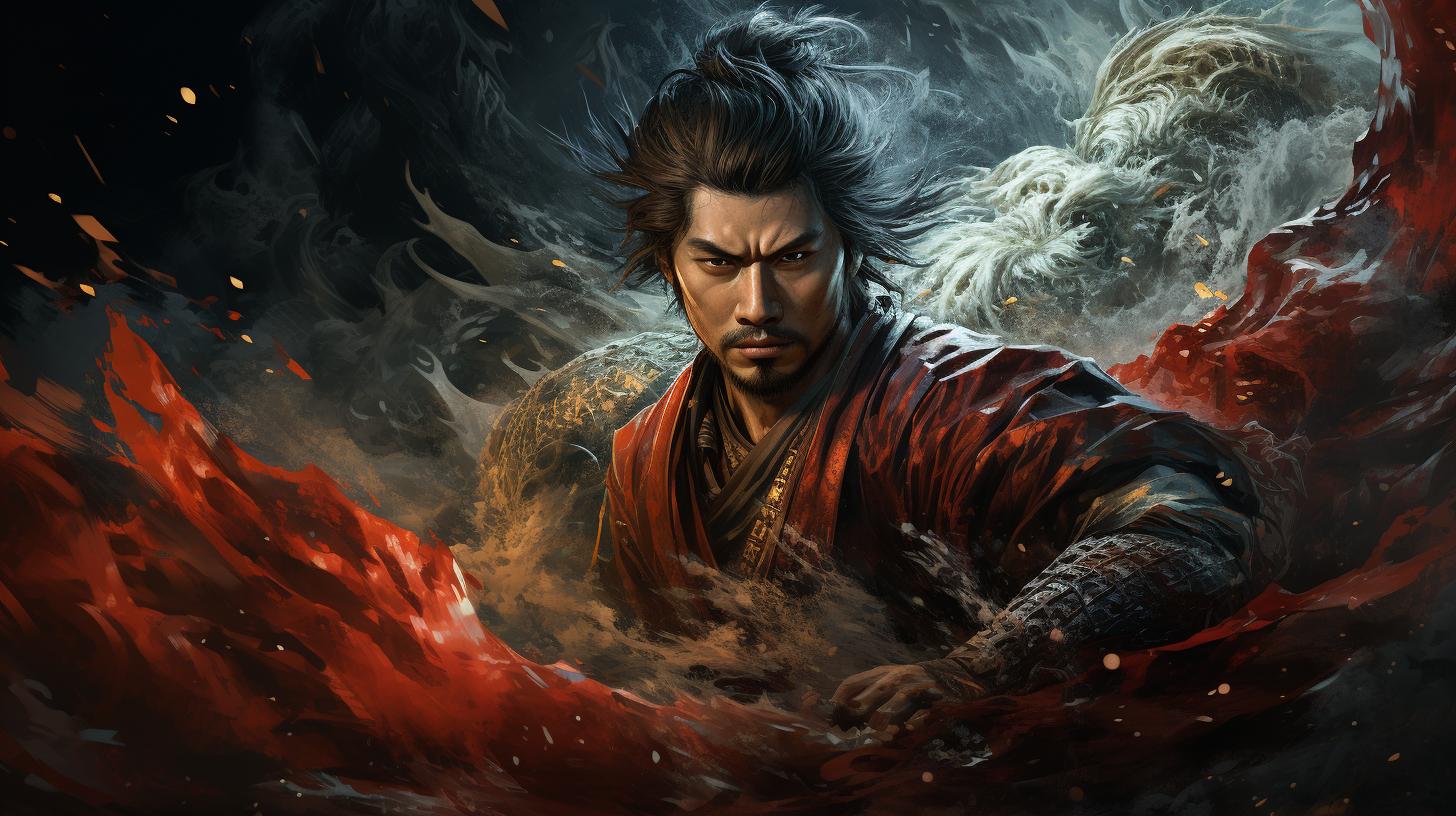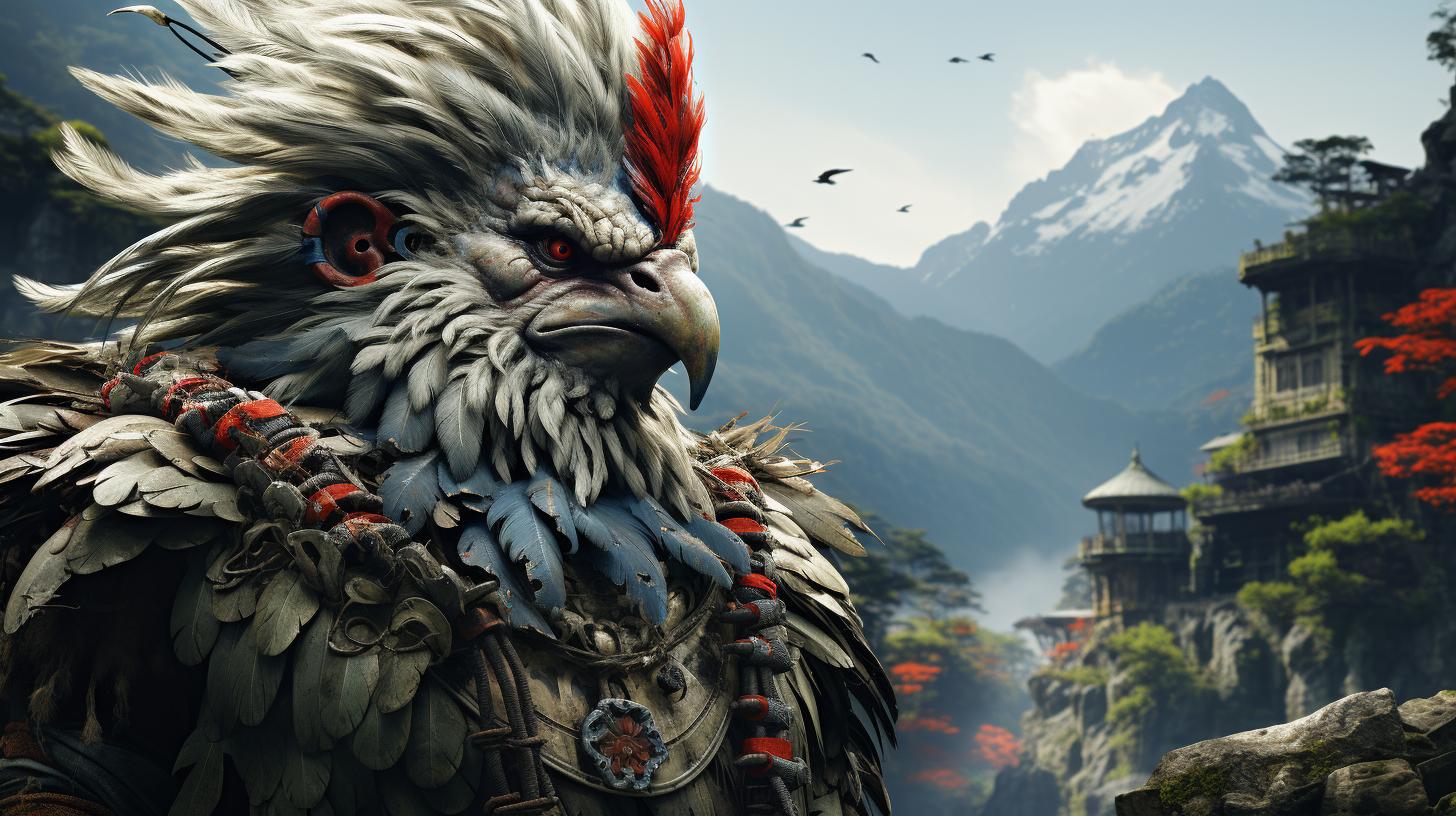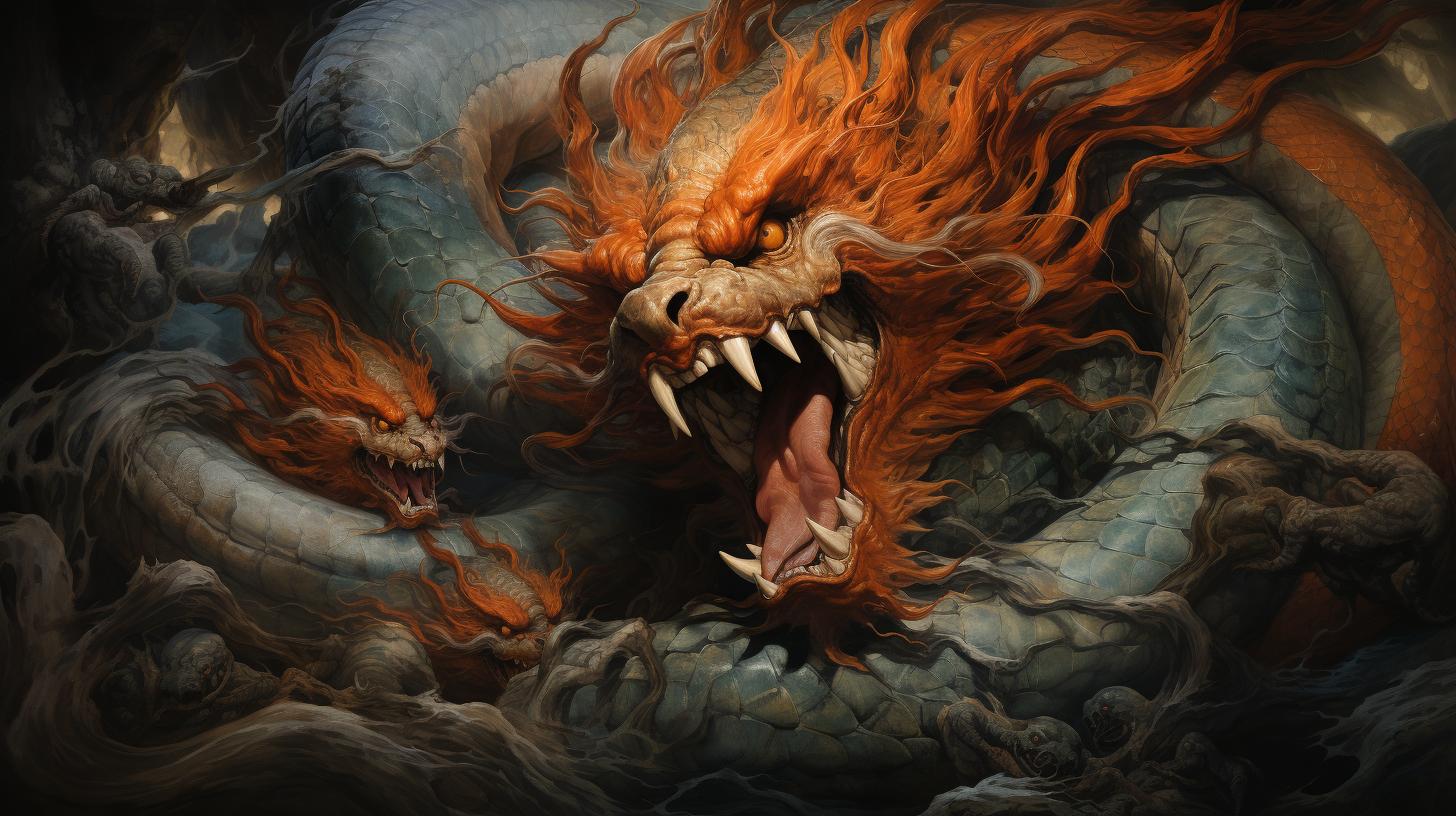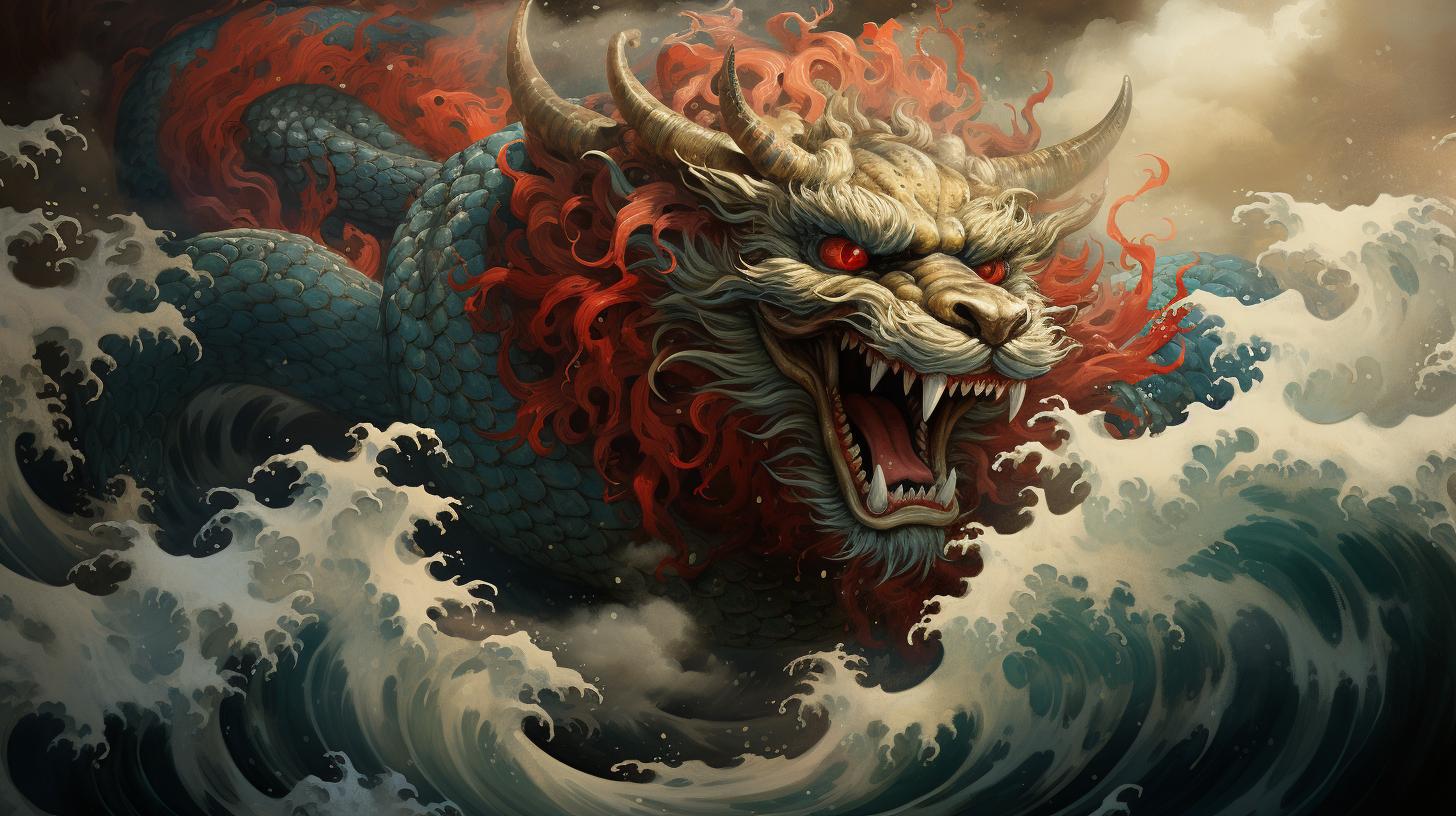Takemikazuchi: The Chief Deity of Swords and Thunder
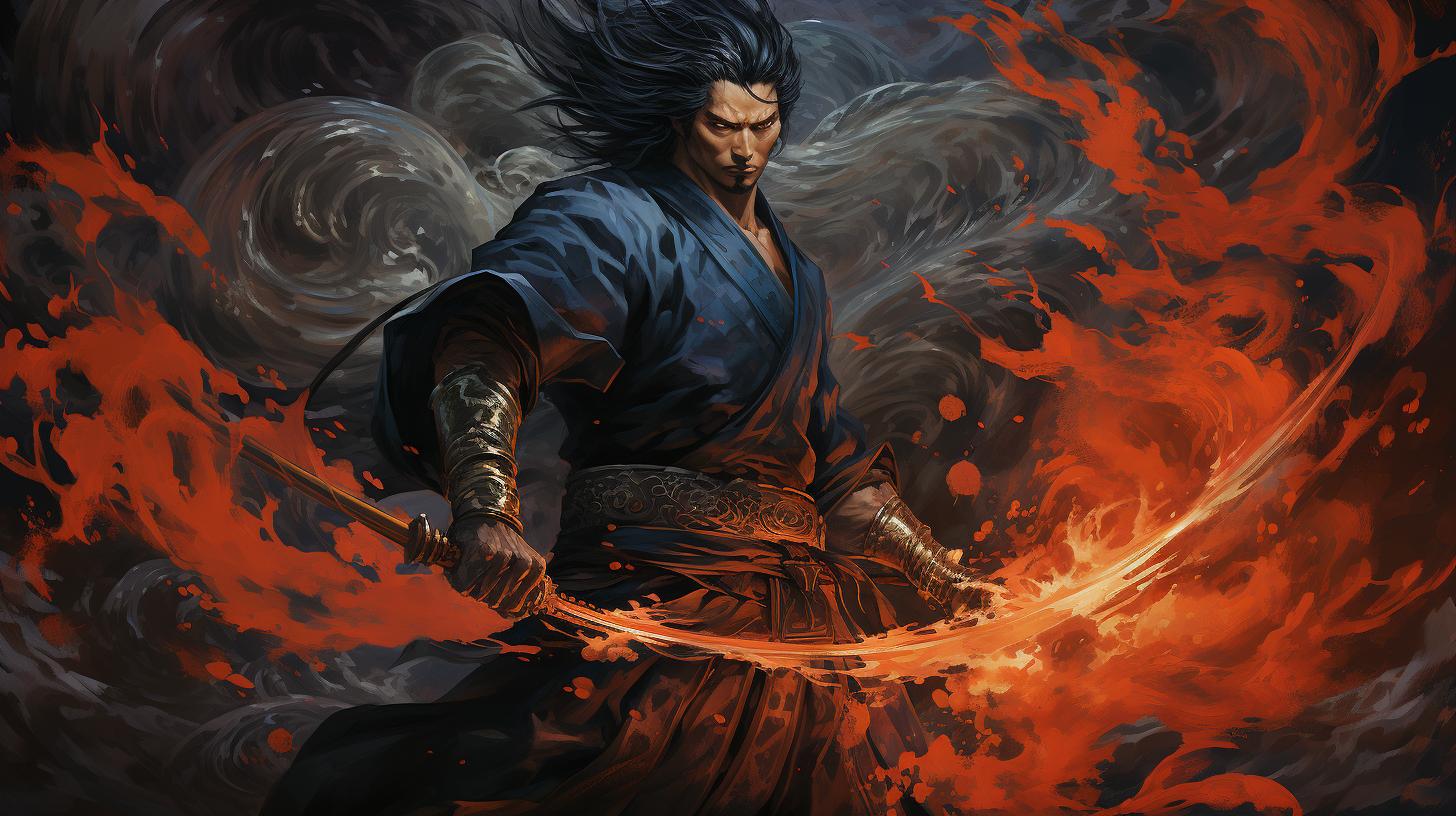
Takemikazuchi, also renowned as the Japanese god of thunder and swords, or “Takemikazuchi no Kami,” embodies a pivotal role in Japanese mythology and culture. Known by several names, including the revered “Sword God in Japanese,” this deity, also acclaimed as the kami of Kashima, is ardently worshipped at the Grand Shrine of Kashima in the Ibaraki prefecture.
From the earliest times, Takemikazuchi’s presence was felt across Japan, symbolizing his supreme authority and divine might.
Takemikazuchi’s symbolic representation often showcases him valiantly battling a colossal catfish named Namazu, believed to be the cause of earthquakes in Japan. Originating from the profound depths of ancient tales and legends, Takemikazuchi’s role surpasses his association with thunder and swords, positioning him as an intriguing figure in Japanese folklore.
His name, implying “the power of the fist sword,” or “Ten Fist,” resonates with the essence of martial valor and divine might, making him not only a symbol of thunder but also the epitome of swordsmanship and martial prowess.
Explore the rich symbolism, legends, and cultural impact of Takemikazuchi, the Japanese god of swords and thunder, from the earliest documentation in the Kojiki and the Nihon Shoki, identifying him as a sentient god with mind and speech, vital for the conquest of the great land of Japan.
Takemikazuchi: The Japanese God of Thunder and Swords
Origins and Background of Takemikazuchi
Takemikazuchi, a deity revered in ancient Japanese mythology, wields immense power as the god of thunder and swords. His origins are deeply rooted in the creation stories of the Kojiki, where he is celebrated as one of the divine beings born from the blood spilled from Izanagi‘s sword following the decapitation of the fire deity, Kagu-tsuchi.
This dramatic origin story highlights Takemikazuchi’s profound connection to “the blood from the sword,” signifying his role as a purveyor of justice and divine retribution, echoed in the texts of the Asiatic Society and studies on Japanese deities and their themes.
Takemikazuchi in Japanese Mythology
In the annals of Japanese mythology, Takemikazuchi, also known by titles such as Takemikazuchi-no-o no kami and Takefutsu-no-kami, serves as a divine emissary dispatched by the heavenly gods.
His crucial mission involved subjugating the earthly deities and asserting celestial dominance over the mortal realm, alongside Futsunushi, embodying the gods’ thunderous might and martial prowess. His affiliation with the Nakatomi clan, a lineage renowned for their role in Shinto rituals, further cements Takemikazuchi’s significance in establishing the sacral and martial traditions of Japan, fostering a culture deeply embedded in the reverence for the divine and the martial.
Legends and Folklore Surrounding Takemikazuchi
An enthralling legend tied to Takemikazuchi recounts his confrontation with the local deity Ōkuninushi in the Izumo region. Demanding sovereignty over the province of Izumo, Takemikazuchi challenges Ōkuninushi’s progeny to determine the rightful ruler.
While Kotoshironushi yields to Takemikazuchi’s demand, Takeminakata opts for combat. Takemikazuchi’s formidable might leads to Takeminakata’s defeat, prompting his exile and subsequent worship as the chief deity of the Suwa Grand Shrine in Nagano prefecture.
This tale, chronicled in the ancient texts, illuminates the intertwined nature of martial valor and divine decree in the shaping of Japan’s mythological landscape.
In Japanese folklore, Takemikazuchi is also celebrated for his role in assisting Emperor Jimmu’s conquest of the eastern lands. It is believed that Takemikazuchi’s divine blade, the fist sword Totsuka, a celestial weapon sent down from heaven, was instrumental in subduing local deities in Kumano, underscoring Takemikazuchi’s pivotal presence in major historical events and his undying influence on Japanese folk religion and the ethos of the samurai.
Symbolism and Representations of Takemikazuchi
Takemikazuchi’s reverence extends beyond his roles as the god of thunder and swords. He embodies profound symbolism and is depicted in various forms within Japanese culture. This section delves into Takemikazuchi’s symbolism and his depiction in art and iconography, capturing his essence as a protector and divine warrior, perpetually ready to deploy his celestial power in defense of the realm and its people.
Takemikazuchi’s Role as the God of Thunder
As the deity of thunder, Takemikazuchi is linked with the awe-inspiring phenomena of lightning and thunderstorms. His dominion over thunder symbolizes power, fortitude, and the raw might of nature. In Japanese mythology, Takemikazuchi’s thunder is seen as a manifestation of divine authority, capable of bringing both blessings and destruction to the mortal realm.
The Connection between Takemikazuchi and Swords
Notably, Takemikazuchi’s association with swords stems from his origins as a warrior deity. The divine sword he possesses, including the famed Ohabari, which was previously wielded for the conquest of Itsu, signifies his unyielding commitment to upholding justice and righteousness.
Swords hold significant cultural and historical importance in Japan, symbolizing honor, loyalty, and the samurai way. Takemikazuchi’s connection with swords highlights his role as a protector and enforcer of divine justice.
The divine sword he possesses is believed to possess immense power, capable of subduing evil forces and ensuring harmony.
Depictions of Takemikazuchi in Art and Iconography
Takemikazuchi’s presence and influence can be seen in various forms of Japanese art and iconography. From ancient sculptures to contemporary artworks, he is often portrayed wielding a sword, ready to unleash his divine power.
His portrayal in art often incorporates symbols of his dual dominion over thunder and martial prowess, such as the depiction of thunder gods and the intricate symbolism associated with his legendary conquests and battles against malevolent forces.
Takemikazuchi’s portrayal showcases his strong and imposing stature, emphasizing his role as a formidable deity and symbol of protection against malevolent forces.
In traditional Japanese paintings and woodblock prints, Takemikazuchi is depicted in captivating scenes, often accompanied by intricate details representing thunder, lightning, or the symbolic imagery of a catfish—the representation of Namazu, the source of earthquakes.
This imagery not only captures the essence of Takemikazuchi’s power over natural phenomena but also his prowess as the supreme god of swords, showcasing his divine role in maintaining balance and enforcing justice.
Through these artistic representations, the god’s power and significance are visually conveyed, evoking a sense of reverence and awe. His connection with swords, symbolizing his role as a protector and enforcer of justice, is highlighted through the depiction of the legendary “Ten Fist Sword,” sent down from the heavens to aid in the conquests of the great land of Japan.
In conclusion, Takemikazuchi’s symbolism and representations in Japanese culture are rooted in his roles as the god of thunder and swords. As the divine controller of thunder, he symbolizes power and the might of nature, whereas his association with the “Sword sent down for military success” signifies his crucial role in the realm of martial valor and strategic warfare.
Depicted in art and iconography, Takemikazuchi’s imposing presence conveys his divine power and serves as a reminder of his significance in Japanese mythology and belief systems, encompassing both the awe of the natural world and the disciplined sphere of military endeavor.
Takemikazuchi’s Interactions and Impact in Japanese Culture
Takemikazuchi’s Conquest of the Middle Country
One significant aspect of Takemikazuchi’s role in Japanese culture is his involvement in the conquest of the Middle Country. According to mythological accounts, Takemikazuchi, the Japanese god of swords and thunder, alongside Futsunushi, was originally sent by the heavenly gods to subdue the earthly gods.
In the region of Izumo, he demanded that the local god Ōkuninushi relinquish control of the Izumo province. The latter allowed his children to decide the fate, and Kotoshironushi agreed to step aside.
However, Takeminakata, another offspring of Ōkuninushi, chose to confront Takemikazuchi in a wrestling match for control. The encounter between the two deities ended with Takemikazuchi, known for his unparalleled swordsmanship, emerging victorious, crushing Takeminakata’s hand, leading the defeated deity to exile himself in the Suwa region, where he became the primary god of the Great Suwa Shrine in Nagano prefecture.
His exploits, detailed in ancient scriptures like the Kojiki and the Nihon Shoki, illustrate his significance as the god of swords in Japan, embodying martial valor and divine justice.
Takemikazuchi’s Influence on Military Campaigns
Takemikazuchi’s association with military campaigns in Japanese history solidifies his significance.
Paired with the god Futsunushi, and often invoked together within the Zasshi code, Takemikazuchi served as a symbol of victory and protection, believed to ensure success in military endeavors. The shrines at Kashima and Katori, both dedicated to him, became central locations for military strategy discussions and prayers for victory.
Praying to these gods was customary among warriors, as they sought divine assistance in battles and conquests. Their worship played a crucial role in instilling confidence and motivation among soldiers, further emphasizing Takemikazuchi’s influence on military campaigns throughout Japan’s history.
Takemikazuchi’s Shrines and Worship Practices in Japan
Takemikazuchi’s revered status led to the establishment of various shrines dedicated to him across Japan, notably the Kashima Shrine in Ibaraki prefecture, a place deeply associated with his legend and the center of worship for this powerful deity.
The Kashima Shrine, along with the Isonokami Shrine, stands as a testament to Takemikazuchi’s enduring legacy in the realm of the divine and the martial, attracting devotees who seek his blessings for military success and protection.
The Isonokami Shrine is said to house the sacred sword of Takemikazuchi, a symbol of his divine authority and martial prowess, which played a pivotal role in Emperor Jimmu’s conquest of the East.
These shrines serve as cultural and religious landmarks, capturing the essence of Takemikazuchi’s impact on Japanese society throughout the centuries, celebrating his role as the star god, protector, and enforcer of divine order.
To explore Takemikazuchi’s influence further, it is crucial to understand the symbolism he embodies, the fascinating stories associated with him, and how his representation in art reflects his divine stature and his integral role in shaping the spiritual and martial landscape of Japan.
His story, enriched by sources such as the Hyakka Jiten and Kogo Shūi, continues to inspire and instill awe in the hearts of many.











